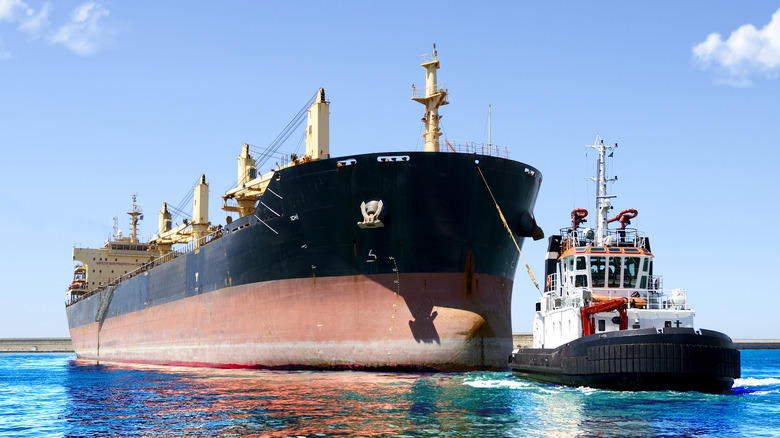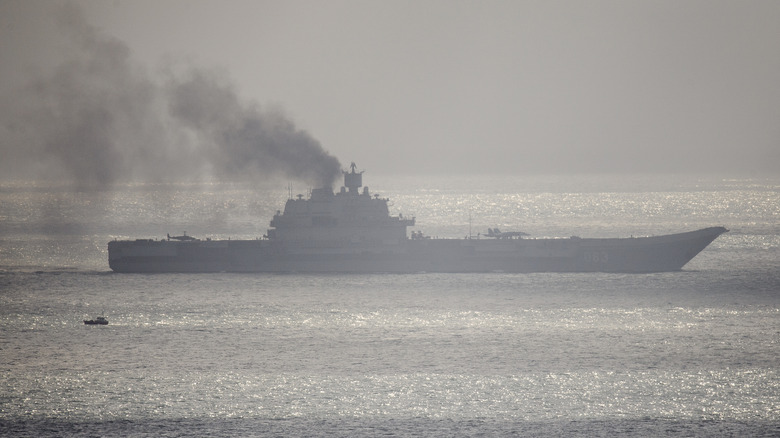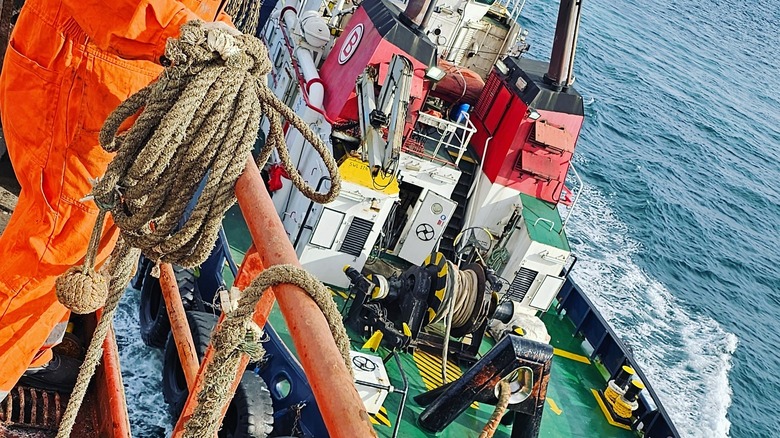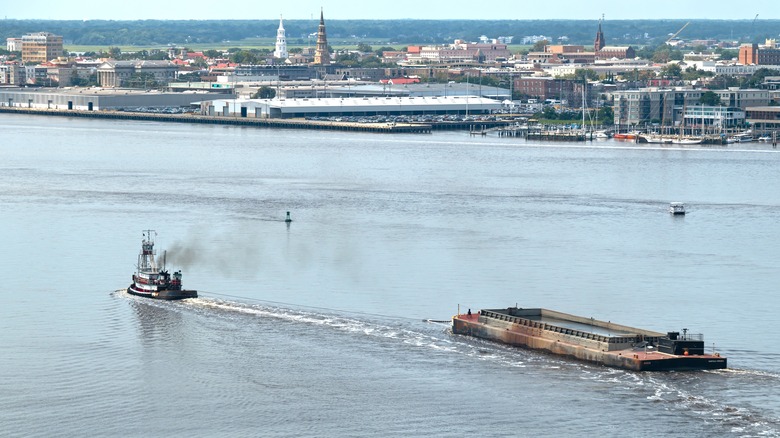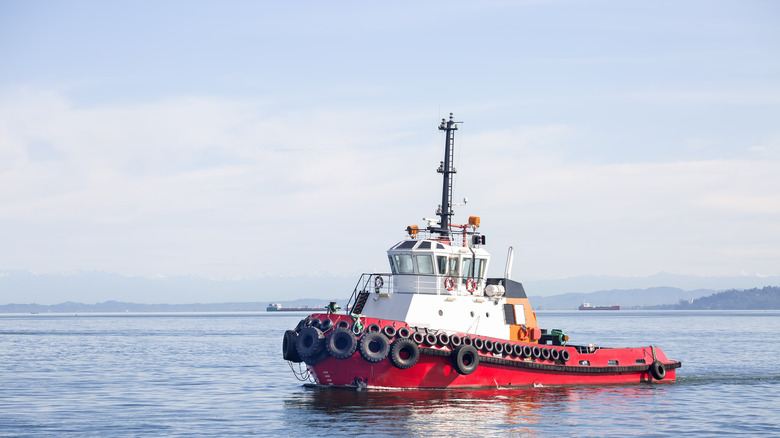The Secret Behind What Makes Tugboats Strong Enough To Tow Massive Ships
It's easy to equate strength with size. Does a great white shark wield more power than a tiny sprat? Well, yes, but there's much more to the equation than that. Relative to its body weight, the horned dung beetle – all 10 millimeters of it – is one of the world's strongest animals, capable of rolling its favorite food in balls that weigh as much as 1,141 times more than it does itself. By a similar token, you might look at a vast cruise ship and a relatively tiny tugboat and think that there could only possibly be one winner there. The U.S. Navy has also wielded some of the smallest tugboats around. As it turns out, though, your average tugboat really is a horned dung beetle of the ocean.
As one tugboat captain, David Missroon, boasted of his vessel to Popular Mechanics in February 2010, "She's got the strength of a center in the NFL with the speed and agility of a defensive end." All of this is packed into a relatively small body: The vessel in question, the Edward J. Moran (not pictured here) is approximately 30 meters long, with a deadweight of 228 tonnes and measuring 11 meters at the beam.
Considering the size of some of the vessels that tugboats are charged with leading, towing, and rescuing, it's difficult to picture where all this NFL center strength comes from. The key is not only the considerable horsepower of a tugboat (which measures 6,500 hp in the case of the Edward J. Moran), but also the brilliant way in which it's deployed.
The size of tugboats' tremendous charges
Cruise ships are some of the largest and mightiest vessels on the oceans. Royal Caribbean's $2 billion Icon of the Seas, for instance, is very appropriately named, the biggest ship of its kind on the oceans at just under 1,200 feet long and with room for a ludicrous 7,600 passengers. Even when everything's in perfect working order, a vessel of this size can struggle to maneuver its way through certain bodies of water. At such times, an enterprising little tugboat – or several – come in to assist.
Aircraft carriers and cruise ships are similar in size, though the former tends to be lighter and faster. They are undoubtedly some of the largest vessels on the oceans, though, and they are also frequently in need of tugboat servicing, directing, and other support. Early in 2012, the Russian Admiral Kuznetsov carrier lost power on its way back home through European waters, requiring rescue from the tugboat Nikolay Chiker. "The Kuznetsov," Popular Mechanics reports, "fires a line-carrying projectile ... at the tug. Chiker's crew takes up the line and begins the towing process."
As we've seen, there's an awful lot of horsepower in a tugboat. The key to this is boasting a potent, reliable engine, and unsurprisingly, diesel is often the key to these. Cummings currently boasts the QSK95 V-16, which the brand declares to be "the most powerful high-speed engine ever built for marine vessels." Even so, when you're towing a vessel several times larger than yourself, as the Russian navy's Nikolay Chiker was that day, something rather more sophisticated than raw strength alone is needed.
How do tug boats pull these enormous vessels?
Interesting Engineering puts the outrageous power of a tugboat into perspective, noting,"don't be fooled by their size: they're powerful enough to move vessels up to 1,000 times bigger than them." They are, as such, as relatively powerful as a horned dung beetle, and it's mesmerizing and a little perplexing to watch them in action. Their strength looks impossible to those who aren't well-versed in what's happening under the steely skin of a tug, but it starts with a fundamental aspect of their design, Interesting Engineering goes on: "they're practically all engine." There's no need for superfluous elements that could detract from a tug's pulling power, and the end result is that a tug can be optimized to its role to an astonishing degree: A cargo ship might have a weight to power ratio of just 1.2, while a tug can reach as high as eight times this value.
Why is this figure so relatively low in the case of a cargo ship? Because those vessels are also specialized in their way: Cargo ships need to transport as many containers as possible, safely and steadily rather than quickly, and in order to reduce their environmental impact in terms of emissions. Slow and steady wins the race, after all, as a famous hare once learned to its chagrin. This, then, is the key to the deceptive strength of a tugboat generally. You could think of them, to a degree, as the equivalent of a fit, toned, human body that's primarily muscle. The next important part of the equation is the actual mechanism these little powerhouses use to tow their huge charges.
How the towing itself works
If you're a driver that has experience in either towing others or being towed, you've probably been party to your share of tow cable-supported driving. This is one important tool that tugboats have in their collective repertoire, providing a simple yet strong direct connection between the vessels. These lines are far more sophisticated than simple lengths of rope, as one would expect. As the British Tugowners Association describes it, "tow ropes have developed to become more than simply a line, it is more akin to a towing system ... each component should be considered independently, and how they relate together — pendant, mainline, and backer."
The last of these is attached to the drum, per Samson Rope, and "should have a high coefficient of friction to help maintain its position on the winch drum." The pendant, at the other end of the line, is the section that is directly attached to the towed ship and is designed to take the majority of the strain and of the wear. In this way, there's much less frequent need to replace the rest of this sophisticated rope system. In tandem with the longest and strongest section of the rope, the mainline, each element of the surprisingly sophisticated tow line is designed to perform together and very efficiently, thereby being much hardier than you might consider a 'simple' length of rope to be. This, then, makes the tugging capacity of a tugboat incredibly strong when used in such a fashion.
The sheer maneuverability of a tugboat
There's another vital strength that a tugboat wields beyond raw power: Agility. After all, with tugboats having the primary utility of guiding their larger brethren through tricky spots, it's vital for the tugs to be able to approach from all angles in often less-than-ideal conditions.
In order to do this, tugboats are equipped with sophisticated propellers that allow them to make movements that they certainly wouldn't be capable of using engine power alone. As Serap Özhan Doğan writes in the 2023 study "Propeller design and verification studies for 30–35-meter tugboats," the propeller is "the driving force of the tug and enables the vessel to perform maneuvers such as berthing, mooring, towing or pushing. Modern tugboat propellers are driven by hydraulic or electric motors. They can even turn backwards when slowing down or stopping is required."
They also have important targets to hit precisely. You may have seen a tug pushing a larger vessel directly, but in order to do so, of course, they won't simply steer indiscriminately into said vessels and shunt them along. There are specific areas on the exterior of such ships that are designed for this purpose, and through their sheer maneuverability, they can both produce a lot of thrust and direct it carefully, all of which adds up to one very strong ship indeed.
Tugboats, crucially, are not one and the same. In 2021, the California Air Resources Board noted that the 229 towing boats in the state consisted of escort tugs, push tugs, and ATB (Articulated Tug Barge) tugs. Though they may vary in some aspects, they each share similar extraordinary strength.
